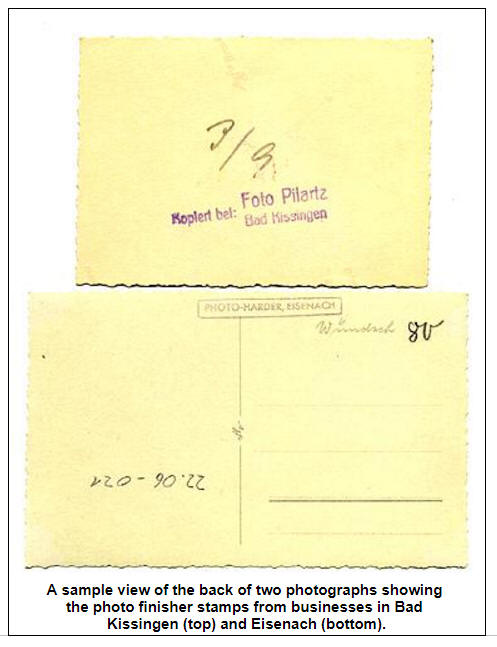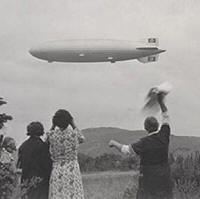| |
Notes on This Collection of Images
In the early
summer of 2004, one of the most respected dealers in German
photographic images placed 35 lots into auction on E Bay
Deutschland, a total of 135 images. Some auctions were for a
single image, others were for groups of as many as ten
photographs; all auctions had the same generic title, (in
German)" Photographs related to one soldier in Eisenach and
other locations".
As I viewed the scans, although they were not in time line order
and grouped more or less by general topic, I recognized that
these were photographs made or collected by a member of the 2
 Kradschutzen
Battalion in the pre war years while stationed at Eisenach, Bad
Kissingen and Eisenstadt, Austria. Kradschutzen
Battalion in the pre war years while stationed at Eisenach, Bad
Kissingen and Eisenstadt, Austria.
In exchanging e-mail with the seller, I learned that less than
1/3 of the images had captions and that they usually consisted
of hand written names or locations and that even for a native
speaker, were very difficult to read. He guaranteed that all the
photos came for one source, a single envelope he had purchased
at a flea market.
I bid on all the items and won about 60% of the total images. I
saved all the scans from the auction to maintain at least a
digital whole to the collection. For those auctions not won, the
original images are scattered to collectors all over the world
and the significance of the collection as one man's memory is
lost. In our photo album, we present a selection of images, both
won at auction and the lesser quality E Bay display scans, to
give the viewer a sense of what one enlisted man's life was like
in the 2 Kradschutzen Battalion in the pre war years
History
Detective
A surprising number of the actual photographs were either
developed or copied in Bad Kissingen. Often but not always,
German photo finishing shops stamped their name and address
on the reverse of images they printed. It appears that the
man who first assembled the collection may have at least
 in
part, been borrowing negatives or prints from his friends to
have his own prints made. Also, many of the photos vary in
size. From that period, this indicates that several
different cameras took the photos. This is further evidence
that the collection was "assembled" by someone. Finally,
some of the images are printed in post card size on heavy
stock, also common to the period. Almost every small town in
Germany had a photo shop often run by an amateur
photographer. He would capture images of note in the life of
the town and then sell prints for a Mark or two. Some of the
best images showing military life at Eisenach are in this
format. in
part, been borrowing negatives or prints from his friends to
have his own prints made. Also, many of the photos vary in
size. From that period, this indicates that several
different cameras took the photos. This is further evidence
that the collection was "assembled" by someone. Finally,
some of the images are printed in post card size on heavy
stock, also common to the period. Almost every small town in
Germany had a photo shop often run by an amateur
photographer. He would capture images of note in the life of
the town and then sell prints for a Mark or two. Some of the
best images showing military life at Eisenach are in this
format.
It is difficult to tell if the person who collected the
images is in any of the photos. The common method Germans of
that period used to indicate "this is me" was to put an ink
X over their head in an image. This is not seen on any of
the pictures, although one image has an X on the back of the
photo over one of the troopers. Many faces, his squad
members (?) appear in several images.
Some of the photographs were captioned only as "HW"; two
images were marked as "H Wundsch", clearly a name and
perhaps the name of the soldier who assembled the
collection.
It is also difficult to tell exactly what this soldier's
duty position was. He was an enlisted man, I think he was a
dispatch motorcycle rider, not a driver of a side car set.
The most detailed image of a motorcycle is of a "single" ,
as if to say, "this is my bike, or my bike is just like this
one". Also, there are several images of German riders
without sidecars, this leads us to believe that he was a
message rider taking or assembling photos of his friends.
There are a few photos of the 37mm anti - tank cannon, a
weapon found in the combat support company of a Krad
battalion. Perhaps this was his company.
Even though the
photographs, when put in estimated time line order do tell a
recognizable story, there are huge gaps in time or topic and
it is impossible to correctly date from context some of the
more generic scenes. There are two exterior views of
Manteuffel Kaserne and several photos of Bad Kissingen.
There is a long series of photos of the serviceman
apparently on leave, it is difficult to say if this was from
the Eisenach or Bad Kissingen period. There are many photos
of the military march from Bad Kissingen to Austria, March
1938, as he took note of the new sights, yet only a very few
images of the new home near Vienna. There is a selection of
images of barriers and bunkers, probably seen in
Czechoslovakia when his unit participated in the bloodless
annexation of that country, October 1938, and finally a very
few images of combat destruction, probably in Poland.
Between many of these landmark events, months and months
passed with no images in the collection. Were there other
images that some how were lost and what was the fate of this
soldier ... it is unknown.
What we present is a collection of photographs from a single
soldier who was in the first German unit to occupy
Manteuffel Kaserne in Bad Kissingen. He was an eye witness
to history but in many ways, lived a life recognizable to
all soldiers. We have done our best to sequence the photos
in as accurate a time line as is possible. To assist the
viewer in understanding the context of the images, we have
added captions based on the known history of the 2 Krad and
the highly detailed diary of the 38th Anti - tank Battalion,
part of the 2 Panzer Division. This unit was stationed in
Schweinfurt prior to the move to Austria, and it's post war
veterans association reconstituted and published the
complete unit diary.
Because the images of the Zeppelin are rather dramatic, with
a little license, we title the album, "but what I mostly recall is the day the Zeppelin came to
Bad Kissingen ..."

Return to History Part
I
|
|